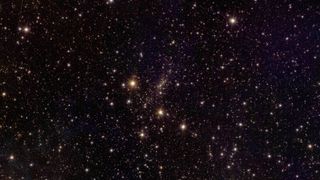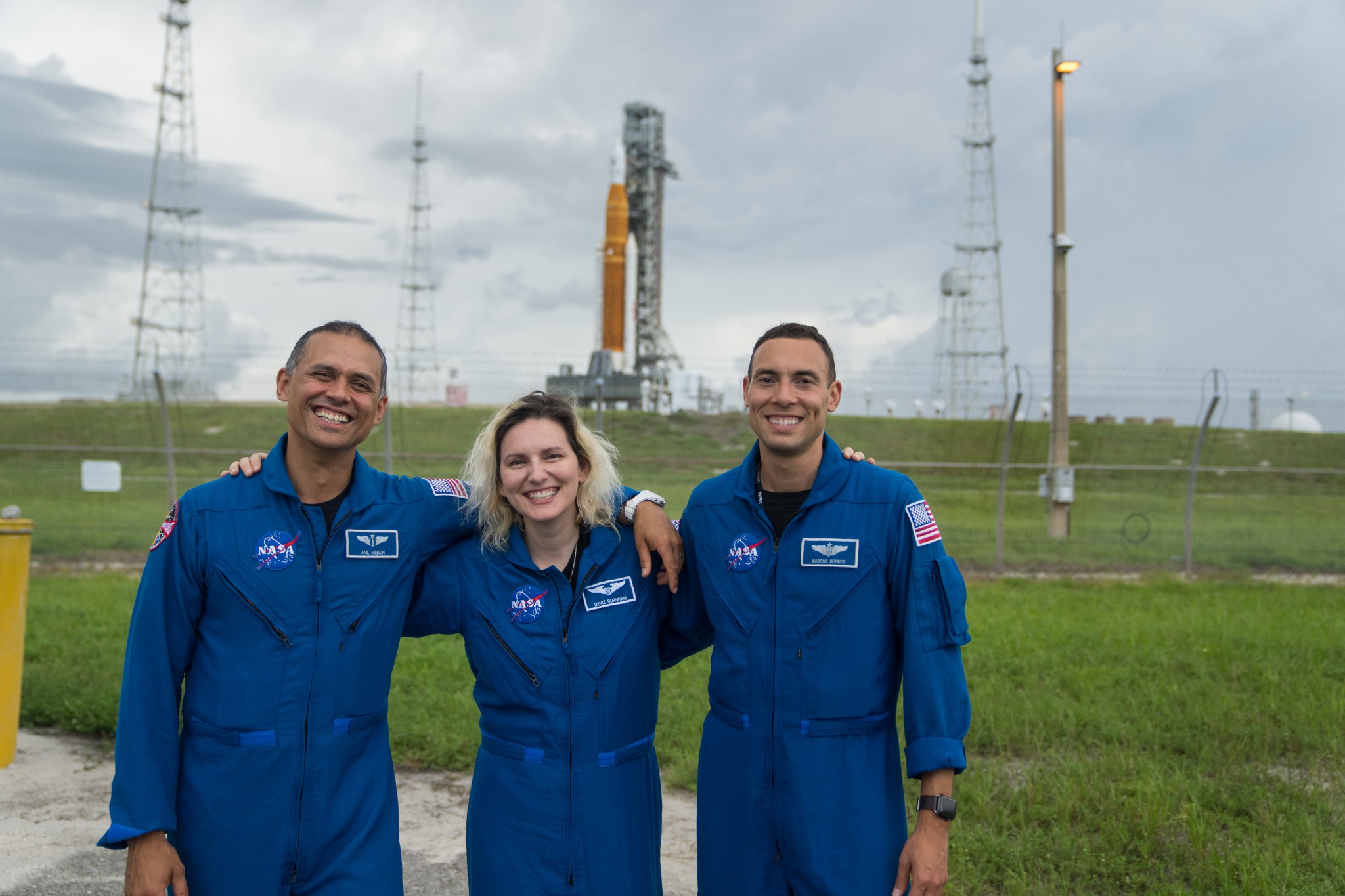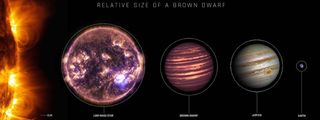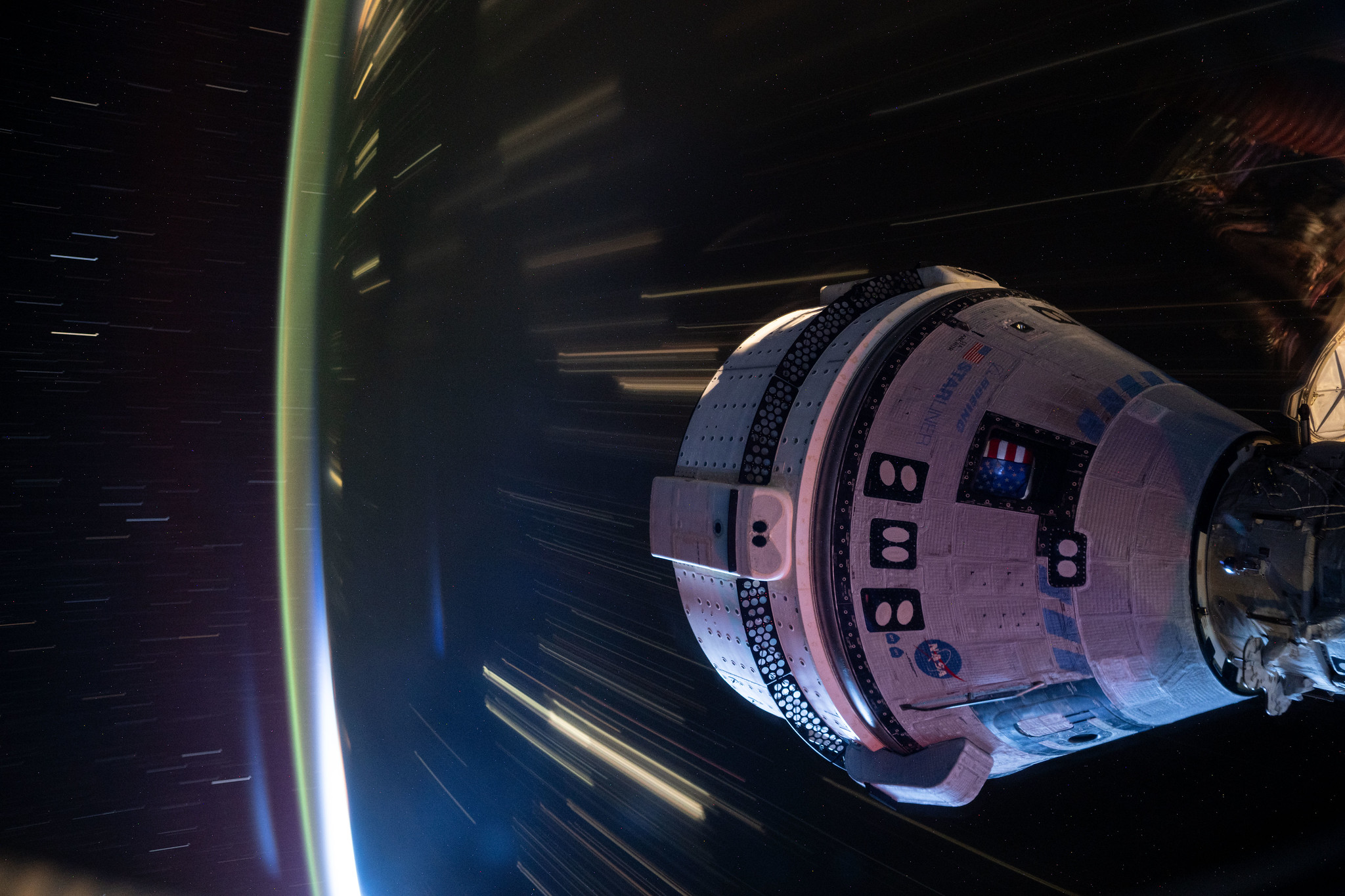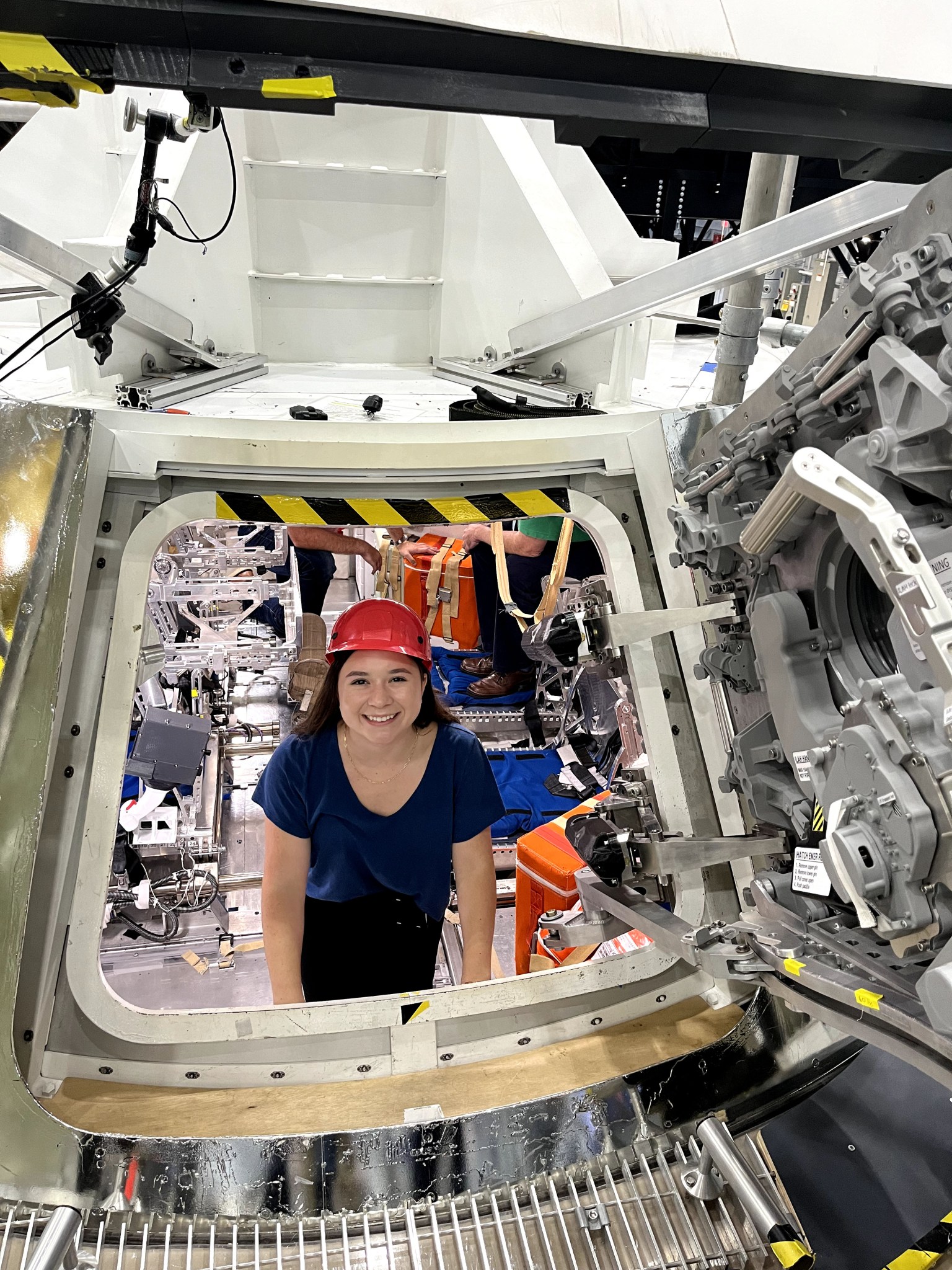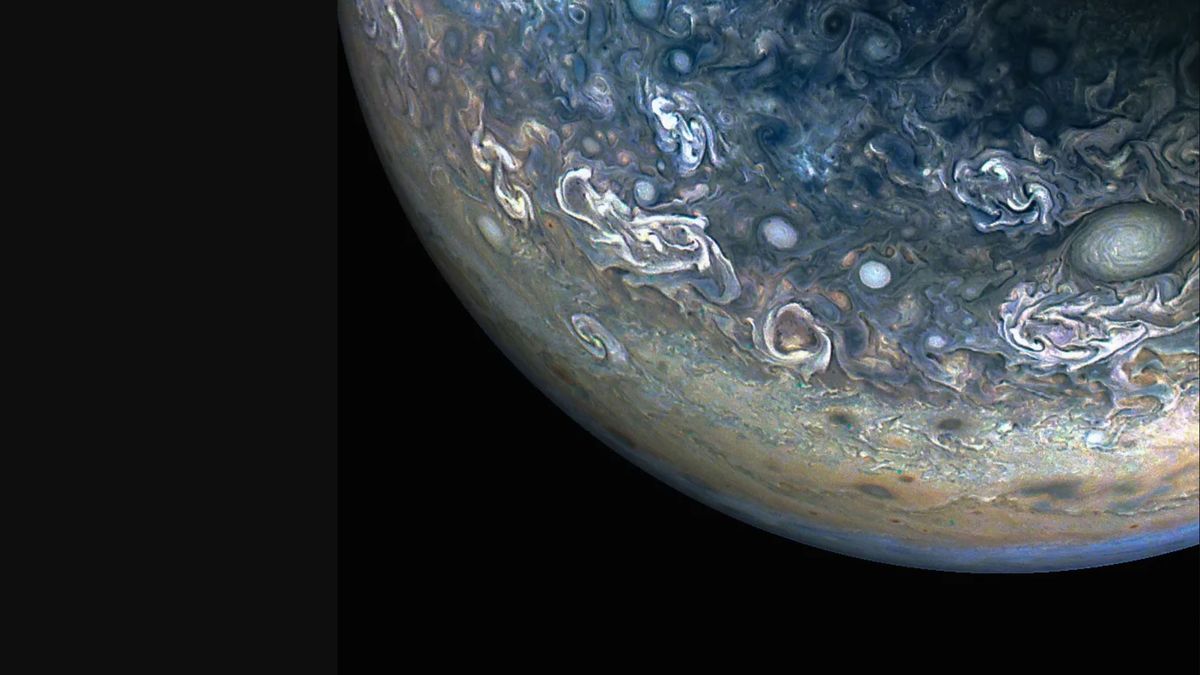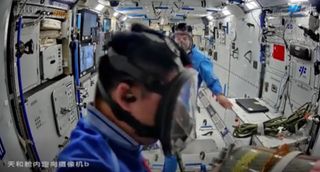By combining a new image of a giant galaxy cluster with older X-ray data, scientists at the European Space Agency (ESA) have demonstrated how the cluster’s galaxies are suffused by huge amounts of gas that can reach scorching temperatures up to 100 million degrees Celsius (180 million degrees Fahrenheit). The galaxy cluster, Abell 2390, was imaged recently by ESA’s Euclid mission, designed to study dark matter and dark energy by probing gravitational lensing occurrences in galaxy clusters. Because these clusters contain so much mass — up to ten trillion solar…
Read MoreMonth: July 2024
From Intern to Astronaut
NASA/Steven Seipel On Sept. 2, 2022, NASA astronauts Anil Menon (left), Deniz Burnham (center), and Marcos Berrios (right) posed for a photograph in front of NASA’s Artemis I SLS (Space Launch System) and Orion spacecraft at the agency’s Kennedy Space Center in Florida. Burnham began her career as an intern at NASA’s Ames Research Center. She earned a bachelor’s degree in chemical engineering from the University of California, San Diego, and a master’s degree in mechanical engineering from the University of Southern California in Los Angeles. Burnham reported for duty in…
Read MoreNASA’s Fermi Finds New Feature in Brightest Gamma-Ray Burst Yet Seen
4 min read NASA’s Fermi Finds New Feature in Brightest Gamma-Ray Burst Yet Seen In October 2022, astronomers were stunned by what was quickly dubbed the BOAT — the brightest-of-all-time gamma-ray burst (GRB). Now an international science team reports that data from NASA’s Fermi Gamma-ray Space Telescope reveals a feature never seen before. The brightest gamma-ray burst yet recorded gave scientists a new high-energy feature to study. Learn what NASA’s Fermi mission saw, and what this feature may be telling us about the burst’s light-speed jets. Credit: NASA’s Goddard Space…
Read MoreRunaway ‘failed star’ races through the cosmos at 1.2 million mph
A newly discovered rogue stellar body may well be a “failed star,” but it certainly isn’t a failure when it comes to velocity! The potential brown dwarf is racing through our Milky Way galaxy at 1.2 million mph (1.9 million kph). That’s about 1,500 times faster than the speed of sound! Thankfully, this cosmic runaway is heading toward the center of the Milky Way and not toward us. However, the object is traveling so fast that it could eventually escape our galaxy entirely. The incredible speed of this newly uncovered…
Read MoreNASA’s Perseverance Rover Scientists Find Intriguing Mars Rock
7 min read Preparations for Next Moonwalk Simulations Underway (and Underwater) NASA’s Perseverance rover discovered “leopard spots” on a reddish rock nicknamed “Cheyava Falls” in Mars’ Jezero Crater in July 2024. Scientists think the spots may indicate that, billions of years ago, the chemical reactions in this rock could have supported microbial life; other explanations are being considered. NASA/JPL-Caltech/MSSS An annotated version of the image of “Cheyava Falls” indicates the markings akin to leopard spots, which have particularly captivated scientists, and the olivine in the rock. The image was captured…
Read MoreUPDATE: NASA, Boeing to Stream Flight Test Mission Briefing on NASA+
Boeing’s Starliner spacecraft that launched NASA’s Crew Flight Test astronauts Butch Wilmore and Suni Williams to the International Space Station is pictured docked to the Harmony module’s forward port. This long-duration photograph was taken at night from the orbital complex as it soared 258 miles above western China. NASA and Boeing will host a news conference with mission leadership at 11:30 a.m. EDT Thursday, July 25, to provide the latest status of the agency’s Boeing Crew Flight Test aboard the International Space Station. NASA previously planned an audio-only media teleconference…
Read MoreThe Future is Bright: Johnson Space Center Interns Shine Throughout Summer Term
More than 100 interns supported operations at NASA’s Johnson Space Center in Houston this summer, each making an important impact on the agency’s mission success. Get to know seven stellar interns nominated by their mentors for their hard work and outstanding contributions. Stella Alcorn stands inside the Orion mockup within Johnson Space Center’s Space Vehicle Mockup Facility. Stella Alcorn Assignment: Engineering Directorate, Guidance, Navigation, and Control Autonomous Flight Systems Branch, Orion Program Education: Aeronautical and Astronautical Engineering, Purdue University; graduating May 2026 Proudest internship accomplishment: Learning a new software program…
Read MoreJupiter’s surreal clouds swirl in new van Gogh-esque view from NASA’s Juno probe (photo)
Vivid clouds swirl across Jupiter’s skies like colorful brushstrokes across a painting in a new photo from NASA‘s Juno spacecraft. The image, taken during the spacecraft’s 61st close flyby of Jupiter on May 12, 2024, hones in on activity in the planet’s northern hemisphere. Juno was approximately 18,000 miles (29,000 kilometers) above Jupiter’s cloud tops when it captured this new view, highlighting the planet’s persistent storms and colorful bands created by strong winds in its atmosphere. “It provides a detailed view of chaotic clouds and cyclonic storms in an area…
Read MoreA Saturnian Summer
NASA, ESA, A. Simon (Goddard Space Flight Center), M.H. Wong (University of California, Berkeley), and the OPAL Team NASA’s Hubble Space Telescope captured this image of Saturn and its colossal rings on July 4, 2020, during summer in the gas giant’s northern hemisphere. Two of Saturn’s icy moons are also clearly visible: Mimas at right, and Enceladus at bottom. The light reddish haze over the northern hemisphere seen in this color composite could be due to heating from increased sunlight, which could either change the atmospheric circulation or remove ices…
Read MoreChinese astronauts simulate a debris-strike emergency on the Tiangong space station (video)
China’s Shenzhou 18 mission staged an emergency drill recently to boost preparedness aboard the country’s space station. Shenzhou 18 commander Ye Guangfu and crewmates Li Cong and Li Guangsu conducted the drill in mid-July to practice procedures for the case of a decompression event aboard the Tiangong space station. The crew worked in collaboration with the ground team in Beijing, simulating the whole process of emergency response to a simulated scenario of space debris striking Tiangong and causing decompression. The astronauts of China’s Shenzhou 18 mission simulate a debris-strike emergency…
Read More